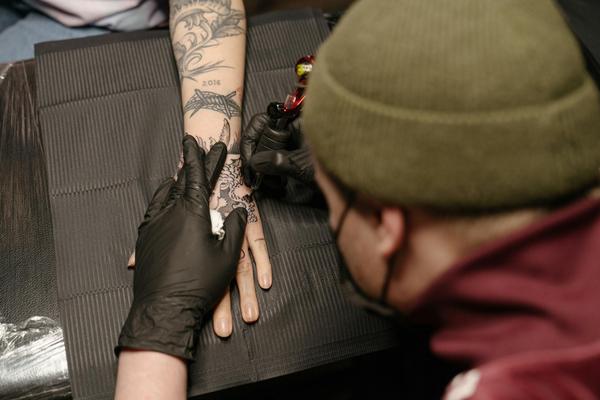
How To Build A Tattoo Portfolio That Lands Your First Client

Sam Hindman
Published onThe tattoo industry is growing more and more with each passing day. In fact, it's had a steady 10% incline every year for nearly a decade. It's no secret why, either; Getting and giving tattoos is an intimate way to express aspects of your emotions physically. It's an experience that has centuries of personal and historic significance. Plus, obviously, it's a really fun time.
If you're one of the many who have been attempting to enter the industry and become a successful tattoo artist, your first unignorable step is to build a quality tattoo portfolio. In this article, we'll be showing you how you can build a quality portfolio that will position yourself as a professional in the tattoo industry. We'll clear up any questions you have about things like length, structure, and how to get your portfolio out there!
Why Tattoo Portfolios Are Important For Artists
The only way to gain experience and become successful is by, first and foremost, getting your name out there. With an art form like tattooing, you can't just ask people to take your word for it. Instead, you need to prove yourself by showing off your talent in the form of a portfolio.
This portfolio is going to be the backbone of all of your interviews and is often the ticket to a novice's first clients and apprenticeships. Not only is it a handy way to have your body of work in one location, but it's also a professional requirement if you want people in the industry to begin taking you seriously.
As you grow, you'll find that your portfolio becomes increasingly important. It can help clients find out, in advance, what your styles and capabilities are, and it also allows you to have references to prior work in times when you might be lacking in inspiration. Having this portfolio is both a necessity and a convenience.
Do Beginner Tattoo Artists Need an Apprenticeship?
The long and the short of it is a resounding 'yes.' Becoming a professional tattoo artist typically involves starting as an apprentice at a tattoo shop. This allows you to learn from seasoned professionals, master the necessary tools, and hone your techniques. It also offers a chance to find a mentor who can provide artistic direction and insights into the tattoo industry.
Should You Have an Online Portfolio or a Physical Portfolio?
This is the tricky part! The correct answer, though you may find it a bit annoying, is both. If you want the best possible chance to grow as a tattoo artist, you're going to need a physical portfolio and an online portfolio. They both have their benefits, but let's briefly describe what each of them brings to the table:
Physical Tattoo Portfolios:
Ideal for approaching employers in tattoo shops for jobs and apprenticeships in person. There's something quite awkward about fiddling around your laptop when discussing a skill as tangible as tattooing.
Shows that you're genuinely willing to put in the work and create something with your hands.
It displays professionalism, as well as a traditional and personal touch that some clients and mentors may prefer.
Allows for high-quality prints that display the details and colors of your work more accurately than an online screen.
Online Tattoo Portfolios:
Ideal for showcasing your skills to prospective clients, as it can be accessed by anyone, anywhere, at any time.
If you have new work, it can be updated in minutes, making it the most current display of your capabilities.
Offers the ability to reach a broader audience, including international opportunities.
It can be shared across social media platforms and other online networks to increase visibility.
You don't have to limit yourself to images; You can include things like multimedia presentations, video content, and other interactive elements.
Choosing Where to Host Your Online Portfolio
Once you've decided to get started with your tattoo portfolio, you have to choose where it will be hosted. Ideally, you want to pick a hosting site that's specifically developed for portfolios. This way, the pre-made templates can be implemented without having to do too much fiddling around.
Naturally, you can go for a website that has a mixture of templates and custom options. You want to emphasize throughout your site that you have a specific artistic style, and sometimes a template can't capture that. However, there's no need to make things overly complex - You don't have to have knowledge in coding to get your tattoos out there!
Generally speaking, pick a hosting site like Journo Portfolio that has the following features:
The ability to have whatever kind of structure you want: sub-pages for categories of works, portfolio items grouped by type on one page, or a featured portfolio item section.
Options for themes and styles that are pre-built, but also the option to customize those elements.
Analytics that allow you to see how your site is performing, where your traffic is coming from, and what pages visitors linger on the most.
The Features of a Quality Tattoo Portfolio
If you want to put your best foot forward when building your tattoo portfolio, there are certain attributes that can make it stand out among the noise. Below, let's discuss some of the features that are included in top-performing tattoo portfolios!
Show Off Your Style
No one, and I mean no one, gets a tattoo because they want to look like everybody else. At their core, tattoos are a form of expression. If you're afraid to express yourself on your own website, then how could a client trust you to successfully create their desired tattoo?
Make sure that, above all else, you don't 'fit in' with other artists. The more unique your style and the more creative ideas you show off, the more likely that you'll attract your dream clients. This gallery is a chance to show the world what makes your art so special; Don't ruin it by trying to be cookie-cutter.
Give Some Variety
Though there might be one particular kind of tattoo that you prefer creating (tribal style, for instance), it's important that early on in your career, you aren't niching yourself and your work down into too narrow of a hole. Meaning: You have to display variety in your portfolio.
When trying to land an apprenticeship, you have to prove to potential mentors that you aren't a one-trick pony. Even if there's a specific design collection that you excel at, versatility is one of the most sought-after traits of a tattoo artist. Make sure that the tattoo designs that you include in your portfolio reflect your skill level and technique as much as they do your personality.
Include as Many Examples as Possible
A big question that might be bouncing around in your head as you create your tattoo portfolio is, "How many pieces should I include?" The answer, as it so happens, is as many as possible! Naturally, if you're a beginner, you won't have hundreds of designs to display. The recommended amount (generally speaking) is 50-100 tattoos in a portfolio. Chances are you haven't even developed this many designs yet, so now is certainly not the time to worry about adding in too many.
That being said, there's always a chance that you have too many to pick from (especially if you're a seasoned artist and have a history of creating drawings). In this case, choose the newest pieces that showcase your skills in the best possible light. It's generally frowned upon to include works in progress, so try to stick to finished pieces.
How Your Tattoo Artist Portfolio Should Be Organized
Organization is a huge part of creating a professional website! You have the unique challenge of piecing together a massive amount of work in a way that is easily digestible and can be happily skimmed through. Luckily, this process isn't particularly difficult.
Your Gallery Page
The 'meat' of your website, so to speak, will be its tattoo gallery. Typically using a grid format, all of your best artwork should be showcased in a way that speaks to your style using a quick glance alone. You could have your gallery on your website's home page so that it's the first thing people see when they want to learn more about you, or it can be a standalone page.
No matter where it is, though, it's important that you also have a level of structure to it. When you're first starting out in your tattooing career, you might not have enough work samples to create separate portfolio pages for each of your different styles. Instead, you can always have the option to sort the portfolio gallery by style or have them strategically placed in groups together.
Your Biography Page
While your tattoo styles and talent should be at the forefront of your portfolio website, it's important to give a little information about yourself, too! There are a lot of people who would be highly interested in learning more about your process and what gave you such an interest in tattoos in the first place!
There are many people who resonate with personal stories, and while the artwork that you create is always going to be the most important part of your tattoo portfolio, it absolutely doesn't hurt to add some additional background about yourself.
Your Contact Page
This might sound like a given, but it's incredibly important to have a contact page that includes information about how to reach you, when you're available, and any social media accounts that those pursuing your site should follow. The tattoo business is built on strong connections, so making sure that your willingness to make those connections is front-and-center on your site can make a big difference in the long run.
Getting Your Tattoo Portfolio in Front of The Right People
Great! Now you have the knowledge to build a tattoo portfolio! But then comes another question: How do you get that portfolio in front of the right people? There are several effective strategies, but we'll go over the most popular. If you're able to follow through with these in a professional manner, you'll be on the road to success in no time at all!
Visit Shops In-Person
As we established briefly earlier, this is an industry that is built on networking and connections. It's important that, aside from virtually, you also physically put your name out there. There are bound to be local tattoo shops in your area, regardless of if you're in a small town or a big city.
Simply take the time to introduce yourself and try to build an amicable relationship with the local shop owners and employees. Even if they aren't open for hires or apprenticeships at the moment, there's always a chance that they will be in the future. Or, they could also connect you to other local establishments that could suit your needs. All you have to do is be likable and show that you care about the craft.
Leverage Social Media
There are a number of people who use social media itself as their portfolio. While this is unwise because any social media account could be banned or restricted at the drop of a hat (consider the potential Tiktok ban, for instance), having a strong social following is still inevitably going to help spread the word that you're talented, successful in many styles, and looking for work. Plus, it's a great way to advertise things like flash sheets and a quick route to connecting with other local tattoo artists.
Attend Tattoo Conventions and Trade Shows
There's no stronger networking opportunity than a convention dedicated to tattooing! This is a great way to show off that physical portfolio and get right up close with your target demographic. If you don't have a lot of shops near where you're based, this is a great way to meet with large groups of other artists all at once.
Start Building an Online Home For Your Tattoo Art Today With Journo Portfolio
Building your tattoo portfolio is a labor of love. It might take quite a bit of time and elbow grease, but it's worth it in the long run to be able to demonstrate how excited you are to break into your dream industry. We hope that this article has equipped you with the knowledge it takes to make those initial, critical steps!
Journo Portfolio prides itself on balancing ease of use and potential for customization, making it one of the best portfolio builders online. It's in the name, after all! Check out our complete list of features, and get started with your free account today.




